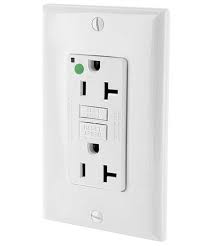 Ground Fault Circuit Interrupter or GFCI A ground fault circuit interrupter, called a GFCI or GFI, is an inexpensive electrical device that can either be installed in your electrical system or built into a power cord to protect you from severe electrical shocks. Most handheld hairdryers have a GFCI as part of their power cord. GFCIs have played a key role in reducing electrocutions. Greater use of GFCIs could further reduce electrocutions and mitigate thousands of electrical burn and shock injuries still occurring in and around the home each year. Ground fault protection is integrated into GFCI receptacles and GFCI circuit breakers for installation into your electrical system, especially for circuit outlets in particularly vulnerable areas such as where electrical equipment is near water. Portable GFCIs are also available to provide on-the-spot ground fault protection even if a GFCI is not installed on the circuit. The GFCI is designed to protect people from severe or fatal electric shocks but because a GFCI detects ground faults, it can also prevent some electrical fires and reduce the severity of other fires by interrupting the flow of electric current. What Is A Ground Fault? A ground fault is an unintentional electrical path between a power source and a grounded surface. Ground faults most often occur when equipment is damaged or defective, such that live electrical parts are no longer adequately protected from unintended contact. If your body provides a path to the ground for this current, you could be burned, severely shocked or electrocuted. How Do They Work? A GFCI constantly monitors current flowing through a circuit. If the current flowing into the circuit differs by a very small amount (as little as 0.006 amperes) from the returning current, the GFCI interrupts power faster than a blink of an eye to prevent a lethal dose of electricity. GFCIs are designed to operate before the electricity can affect your heartbeat. A GFCI works even on two-slot receptacles as it does not require a grounding conductor for it to work! Actually, GFCI’s were first used to provide protection on older ungrounded electrical systems in homes. They worked so well, they soon became the standard in all homes. Here's an example: A bare wire inside an appliance touches its metal case. The case is then charged with electricity. If you touch the appliance with one hand while another part of your body is touching a grounded metal object, such as a water faucet, you will get shocked. If the appliance is plugged into an outlet protected by a GFCI, the power will be shut off before a fatal shock can occur. Where to Install/Use The circuits that require GFCI protection are designated by the National Electrical Code (NEC).1 The NEC typically only applies to new construction/major renovations. The coverage of GFCI protection has gradually increased over the years. NEC GFCI requirements (and effective date-most common are listed): 1968 Underwater pool lighting 1971 Receptacles within 15 feet of pool walls 1971 All equipment used with storable swimming pools 1973 All outdoor receptacles 1974 Construction Sites 1975 Bathrooms, 120-volt pool lights, and fountain equipment 1978 Garages, spas, and hydromassage tubs 1978 Outdoor receptacles above 6ft.6in. grade access exempted 1984 Replacement of non-grounding receptacles with no grounding conductor allowed 1984 Pool cover motors 1984 Distance of GFCI protection extended to 20 feet from pool walls 1987 Unfinished basements 1987 Kitchen countertop receptacles within 6 feet of sink 1987 Boathouses 1990 Crawlspaces (with exception for sump pumps or other dedicated equip.) 1993 Wet bar countertops within 6 feet of sink 1993 Any receptacle replaced in an area presently requiring GFCI 1996 All kitchen counters – not just those within 6 feet of sink 1996 All exterior receptacles except dedicated de-icing tape receptacle 1996 Unfinished accessory buildings at or below grade 1999 Exemption for dedicated equipment in crawlspace removed 2003 Smart “Lock-out” type receptacles required (Mfg. requirement) 2005 Laundry and Utility sinks 2005 Wetbar sinks 2008 All receptacle outlets in damp locations required to be listed as weather resistant. "WR" must show 2011 All receptacle outlets in unfinished basements, except permanently installed fire alarm or burglar alarm system. When a new subdivision is built the builders often build a "Model" home as the first home in the subdivision, it doubles as a sales center and provides an example of what the homes will look like. What many do not realize is that this first home is often the "practice" home for new floor plans, systems and more! We tend to find some very special and unique issues with "Model" homes. This electrical panel is a good example of a special find! On first look it looks like a normal service entrance panel with the main breaker and two sets of 240v breakers. But once you remove the panel cover...... Surprise! We have a third set of breakers that were hidden! This is why it is so important to get that new home inspected and never buy a new home, especially a "Model" Home without a full home inspection! |
AuthorScott Patterson has been a professional home inspector since 1995. Scott works out of the Greater Nashville TN area. Contact his team at Trace Inspections for all of your inspection needs. Archives
May 2024
|


 RSS Feed
RSS Feed 


